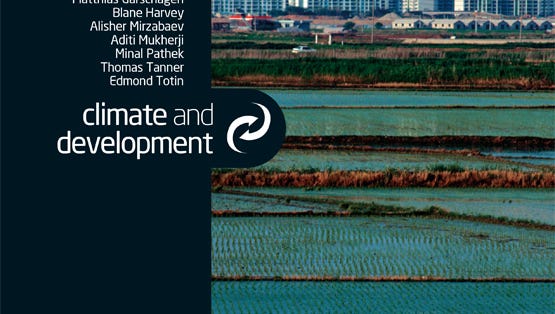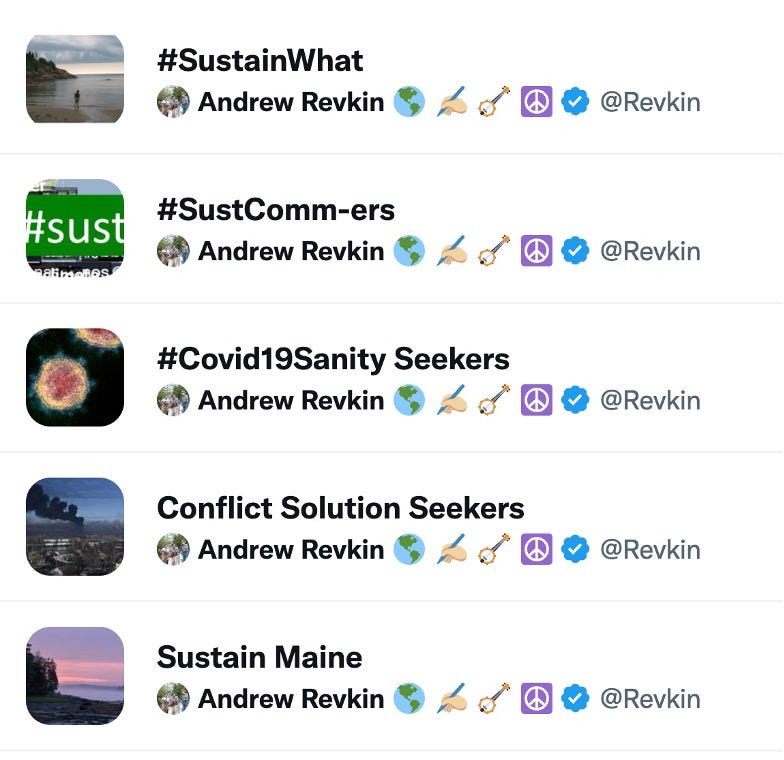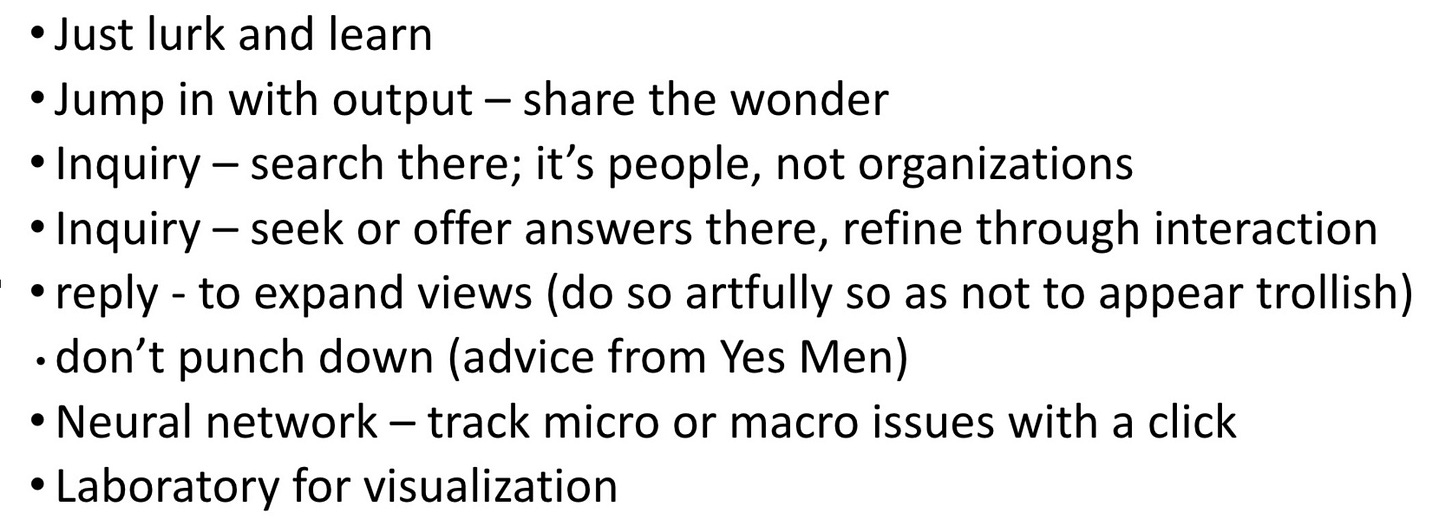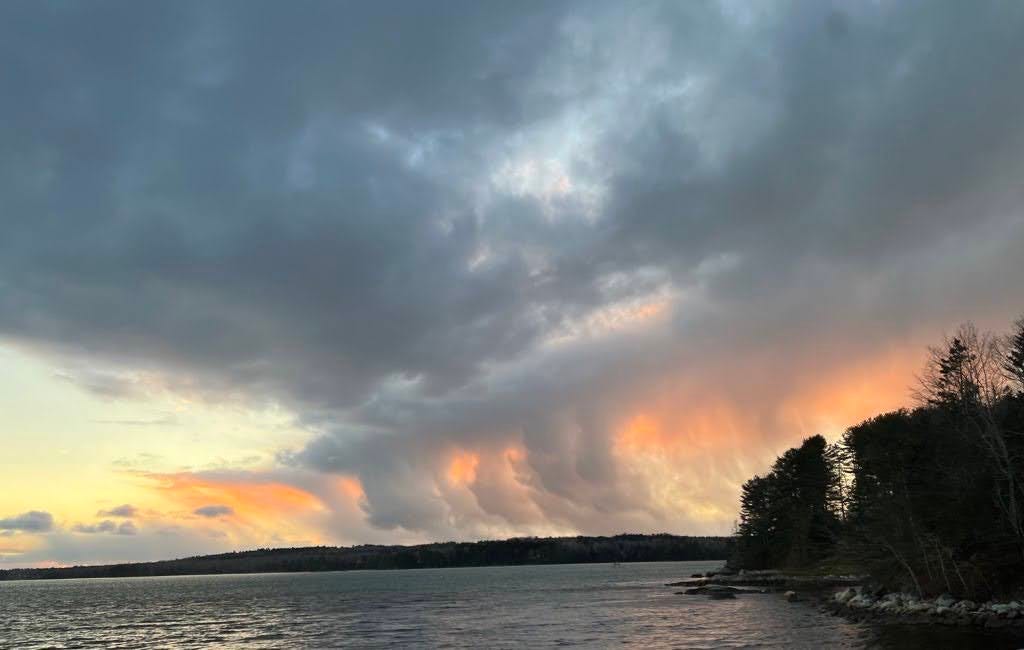The video above is an excerpt from a webinar I just held for Columbia Climate School colleagues eager to sift for strategies making the most of online connectivity amid epic shifts, including Elon Musk’s Twitter takeover. My internal work here at Columbia is focused on building science and policy communication pathways that are about more than clicks. The slides are posted here.
This is a rough transcript (also on Trint here), with links to relevant info added.
Intro: I have written a lot about Twitter in the recent weeks. Actually, I did at the New York Times, too. Some ask, well, why is an environment reporter focused on this stuff? And to me it's pretty clear that the information environment that we live in now is substantially, for better or worse, going to change the real environment.
This is not a new thing, by the way. More than 100 years ago, the extinction of the passenger pigeon was abetted by communication technology - the telegraph. There were people telegraphing "the birds are in" back east and people would get on trains and go out and hunt and with their rifles, their shotguns. And that helped to destroy the passenger pigeon. So the technology at that time was telegraph, but it just shows you that the tools we have now are just like those then. They can be used for good or for ill. The information environment is really an influential part of the biogeophysical environment going forward.
Breaching a barrier
Darwin actually weirdly foresaw some of this in 1871. In his book "The Descent of Man," he said, as we advance in civilization, our tribal nature will ebb. We will be more connected. In his book he went on to say how we'll be connecting with nature, with other species, more this way. He said there's only an artificial barrier to prevent man's sympathies extending extending to men of all nations and races. And technology, in theory, has given us that capacity to truly be the global village that some envisioned many decades ago.

~ ~ ~
This is not in the talk but relevant. The Vatican issued a document in 1963 on the importance of safeguarding the public value of “media of social communication” of that time. Here’s a tweet of mine with the statement:

~ ~ ~
The Sustain What shows I do are split between looking at actual climate policy, climate science and other issues and this question. I did one recently: Can the public value of Twitter be sustained there or elsewhere?
And that's where we're at today. Jim Moffitt, a Twitter engineer who just quit two weeks ago, who I had on this show, explained, even as he's leaving, how much he loves it, and that it took ten years of nonstop programing, regulatory work and other work to create this thing we now know of his Twitter, so don't count on any of the competitors to be able to jump in to take that place anytime soon:
Andy Revkin (to Moffitt): If you step back and look at this from 2007 through 2037, could this be a good thing?
Jim Moffitt: Yeah. I mean, I think Twitter, you know, it's made the need for a public real-time channel like this very obvious. So who knows what will happen with Twitter over the next year or so. But I would have to think that if Twitter moves away from providing that, for whatever reason, something will fill that void. But at the same time, you know, building Twitter was a decade effort. And there's just so much complexity behind it in terms of privacy, in terms of privacy regulations. You know, just the plumbing involved is amazing. And the fact that it's so fast and so public and global. I have no idea how hard that would be to rewrite from scratch? But it's it's not for the faint of heart. And I mean, the engineers I worked with, to a tee, were all super smart, motivated and proud of what they had built. So but that's not to say that not some other service could pop up that provides those characteristics, those features.
Andy Revkin: Jim Moffitt, the guy who's just left Twitter was there [helping developers use] the data. We're going to talk about all the ways we can use the tool directly, but it's worth just touching on this, too. As a data portal, Twitter is amazing - 6,000 tweets a second. So when a flood is unfolding in Jakarta or in Texas, where there are actually good bots - not all bots are bad - that are automatically feeding data into the system to help authorities or emergency response agencies be more effective, and all of us at understanding where flood peril lies and the like. Of course, as I've indicated here, too, there's Trinidad Tobago Weather Center, all around the world the data are being used and input from the public is being used to inform and make more efficient how we deal with emergencies. We had this discussion. In Jakarta (where there's a very high buy in on Twitter in Indonesia) as people are tweeting about the flooding in different parts of this giant city, that builds a picture of what's going on. It's fantastic.
What are your goals?
This is the first communication question always.
So what do you want to get out of the online part of your life? When you think of what you're here for, you're here online right now, obviously you're motivated to think about how to make the most of the Internet and connectivity, maybe pop into the chat as we go forward some of the things you're thinking about what is what is in one word or two, are you looking for connection? Are you looking for answers or you're looking for partners?
What is Twitter really? People
Twitter says “Twitter is what's happening” and “what people are talking about right now.” It's an open system. It's not like Facebook where, you know, you have to be part of Facebook to go into that arena and connect with other people for better or worse.
To me, the big difference between the other Web portals and Twitter is that it's people.
That's revealed by search. I chose two random terms. Maybe one or two of you think about the Arctic and about aerosols. You know, pollution flowing to the Arctic, not just CO2 and affecting the climate are aerosols from wildfires.
So plug those two terms into Google and you get one set of results. Plug those two terms into Twitter as a search engine and you get a completely different thing.
You get people instead of things or ideas. You could take any two or three terms, and I guarantee you in one part of the Internet you'll find stuff, you'll find papers, you'll find organizations.
On the other, you'll find people who are involved in an inquiry on that question. So that's the big first difference, I think.
Dear subscriber or visitor, if you’re on Twitter, please take a minute to think about someone in your scholarly or professional life or networks who would not be there if you weren’t on Twitter. Ponder the odds you would be working with them without this portal. Please post a comment with your answer and/or a relevant link!
Who have you met? Who have you been encountered? Who have you been engaged with recently in your work, your career, or your life track who you met through Twitter?
I have dozens, just one of whom is Katindi Sivi Njonjo, who is a futurist in Nairobi. She's been on my show a number of times. She's working on a program to give kids across Africa the capacity to plan ahead, to think like a futurist. And the only reason I know about her is Twitter. And she's one of hundreds for me, sources and guides and also partners.

Twitter is still where the journalists are
One reason that's a practical reason to think about Twitter seriously is. It's where the journalists are. It's also where politicians are. You know, every politician now has a Twitter account. So if you tag a politician in something, if your work relates to the lobster harvest and right whales and you want to make sure Maine politicians know what you're thinking, tag them. You’re pretty much guaranteed someone in their office will get a look.
There are some portals journalists are moving to. I am among them. I'm set up at post.news. But Twitter is still the domain where the media hang out.
Sam Montano, who teaches emergency management at Mass Maritime Academy is a dynamo. She's on Twitter. She's on TikTok. And she's doing public outreach and also outreach to policymakers and to the media. During COVID, she was posting about how FEMA resources were not being applied to the COVID crisis that could be. She wrote recently in her Disasterology newsletter at Substack about how she ended up on Chris Hayes's show at MSNBC because of her tweets.
So, you know, being there is a way to engage with journalists mostly for the better. And this can have multiple benefits. It's not just getting your story to the journalist.
In 2021, there was this Reuters Hot List of a thousand of the most influential climate scientists. The community of climate-oriented scientists in sub-Saharan Africa took note of the fact that there was hardly anyone from the Global South in this list. And of course, you know, that's because the West, the North had a half century head start being leaders in the science on global warming. You know, it's mostly white Northern guys. And the list reflected that. And so through Twitter, [a batch of African climate researchers] pointed to their article on The Conversation's Africa edition and got a lot of attention from me and others in terms of them saying, hey, Reuters, can we reimagine how you think about who's valuable to the world community as climate change rolls out?


So Twitter levels the playing field and makes the media more responsive. It will. I guarantee you Reuters won't do something like that again without much more circumspection about who should be on such a list. It makes the media more responsive, but only if you engage. Only if you're there. Only if you, the community of people who care about making progress on the planet through communication, are there.
Teaching and Twitter
There's so many ways Twitter matters. I'm just going to tick down some of the ways it's been utilized. When I was at Pace University from 2010 to 2016, I taught a course called Blogging a Better Planet. We had a hash tag #paceblog, and the students were all creating blogs with some facet of what they were working on about how to make the world better. So #paceblog was our class hashtag. #birdclass is my favorite one, from Margaret Rubega. I started writing about her in The New York Times because of her integrating Twitter into her teaching. In thinking forward about what Twitter is about now and, if you think about Twitter, as a capacity more than a specific entity, where we go from here. So this can spill your classroom learning out into the world, and spill the world into your classroom. It's fantastic tool for that. [00:13:59][78.1]
Warming Stripes collaboration
Another reason I know many of you, some of you probably have some of these socks or stockings or ties. Are the warming stripes created by Ed Hawkins primarily some years ago have been become a symbol of climate awareness, its historical record of climate change, temperature told through color. And it's largely emerged because of Twitter. Especially Twitter is a crossroads for collaborative creativity. Ed Hawkins in the U.K.. was posting on Twitter a lot of his variations showing this warming trend through color. And then Alex Radtke, who's an engineer in Germany, not a climate scientist, said, you know, this is interesting, but one of the problems with the warming stripes is they go from like 150 years ago until now. But they don't really inform where we go from here? And he started posting iterations of the stripes and together they've been collaborating on this. I had them both on one of my webcasts. It was the first time they actually met face to face, through a screen. And we had a great discussion of how that happened and how we can foster more of that capacity for multiple geographies, across language, across culture. Taking some question like how do we use color to drive understanding and awareness and action around mitigating warming?
Ask and Answer Questions
Another use of Twitter is to ask questions. You have to build a network to some extent to do that. So the more you have your community, the better. But you don't want the community to be too tight. One thing I worry about on Mastodon, for example, is that it's kind of self-organizing clusters of [people in] disciplines who already know each other creating these little islands on Mastodon. They're linked. But there are really constraints on how much crosstalk can happen or how much discovery can happen, where someone comes along and says, like Alex Radtke did, Well, what about the stripes going forward? So once you build a bit of a community there, then you start to ask questions. David Roberts is a journalist. He's a big part of climate and energy Twitter. He could pose pretty specific tough questions that not are of great interest to the wider Twitter community. They're not there to get attention per se.
Sam Montano Again. Just a couple days ago, November 29th, asked have any emergency management agencies made it onto TikTok yet? It's the fastest growing visual platform by far, beating Instagram and everything. Alaina Wood is a geographer focused on climate who has become a bit of a star on TikTok. So Sam asked this question and right away there was an answer below from the Barton Kim, who says, Ready Harris, which I think is Harris, Pennsylvania, was there. And then Madison County EMA kicked in right away. "We are in the building. Have been for a while. Give us a follow." So you can ask and answer questions. That's a way to build community and refine what you're thinking and what others are thinking.
Thread up!
Threads are really a valuable way, as a scholar, scientist or a student with some project that's done, to build content on Twitter that tells a story. It's a publishing platform just as much as a blog, but it's sitting there in searchable Twitter space so that if it's about sea life in the garbage patch and someone's out there searching for ocean plastic or whatever, they'll find it. This fantastic young journalist, Michael Thomas, has mastered the art of Twitter threads. He's had thousands of shares and reads of his stories. Many really good reporters are out there doing good work but it's hard to get elevated. By creating these clever, drama-driven threads, he's built a great following. His "lede" was: "All across the country, local governments are restricting and banning clean energy projects. I heard rumors that misinformation on Facebook was a major cause of this, so I joined 40 anti-wind and solar groups to see some of it for myself. The results were bleak."



And he takes you through that learning. The great Rebecca Helm, who's a fantastic ocean scientist, did this spectacular thread full of dynamic, moving images. Her opening line: "OMG it literally takes some swimming from Hawaii to California to discover this but wow did we find something shocking in the Great Pacific Garbage Patch." So threads are a way to get intrigue and storytelling into the Twitter space in ways that can fit in those little 280 character boxes.

Defensive tweeting
Through all of this. You want to protect yourself, obviously. Twitter can be incredibly toxic, particularly for women and people of color and other than the traditional gender. And there are tactics and tools and community-building practices that can let you be on Twitter, get the best of it, without being harassed and dangerously exposed or the like. We did a couple of webcasts on this early on. We did them with Pen America, which is a group that supports writers around the country and the world. And Pen America also has a sort of an anti-harassment toolkit that they're sharing increasingly with scientists and scholars, and we connected with them to do some training.
Hidden Twitter tools
There are other ways within Twitter to shield yourself from the full body of what can be weird. You know, overwhelmingly variegated and a mix of harmful and helpful. There are tools within Twitter that are, generally I'd say the awareness of them is pretty low. I'm not using them that much myself, but they're there and they're Communities. So if you go to your Twitter account, if you have one there, that whole little strip of the left hand side that has where you can create lists or or the like. There are also Communities, where you can create a community similar to a Slack group. So you can create subunits within Twitter that where the content only goes to those within that group. And there are all these levels through which you can limit who can see the stuff you're posting. One was created by Eric Holthaus, who is a Columbia grad, a meteorologist, a super Tweeter who is now trying to build a one of the alternatives to Twitter right now. Twitter circles are similar. I encourage you to dig in on each of those little boxes [at the left side of your Twitter window]. They have a whole long tutorial on how to use all these entities and why.
Holthaus and others are building Project Mushroom.

Avoid passive Twitter
One of the points I try to stress: Social media is almost set up to have you sit back and experience it as it's coming at you, as distinct from going into it with a purpose and using it. It's very easy to get sucked down rabbit holes. I do it all the time. So going in with purpose, making sure you're there on a particular day, a particular hour, with something in mind is a good way to do this. Glen Peters is a fantastic scientist over in Europe who is tracking carbon policy and emissions trends and the like. He posted just today, and many have noted that Twitter, that his Twitter timeline and activity levels seem to have changed.



"Have people stopped tweeting or is the timeline changed?" He's wondering if Musk algorithms are shifting. Ukraine tweets are gone. Oliver Geden, a great climate policy wonk in Germany, replied to him a little bit critically: "This only happens to the lazy people who use the AI-curated timeline. Just use 'latest tweets' and all those problems disappear." If you look carefully at your Twitter home base at the top right hand corner, there's a option tool to go from "latest tweets" to "what's happening," which is more tuned algorithmically. So again, there are lots of ways to fine tune your experience to be useful to you.
Make or follow lists
I use Twitter lists. If you're overwhelmed by your feed, if you're feeling it's too toxic or too off the point or too much about K-Pop or maybe the World Cup, create a list. I have a bunch of lists on my Twitter account. One is Sustain What - which is mostly scholars and scientists digging in on big sustainability questions. "Sustcomm-ers" is mostly journalists. "COVID 19 sanity seekers" is what you think. "Conflict solution seekers" was mainly around Ukraine. "Sustain Maine" is people working here in the state I now live in to foster better forestry, ocean practices, science related to mainre change and climate change and the like. So lists can be a way to avoid the passive idea of just looking at your feed and switching to active filtering. Now you don't want to be too filtered because that really takes you into a bubble. That is not a good place to be in a variegated world.
Analytics help gauge what works
Use analytics. Analytics is very valuable. If you feel like you're not getting a lot of responses to your tweets, if you look at the back end, you can see how many visits they got or the engagement there that's not someone liking it or replying to it or retweeting it. Quite often there can be quite a lot of [invisible] engagement. That's just people coming in, looking, being quiet. We miss those voices because they're not there, but they're significant. Don't worry too much about numbers. I focus more on quality. Knowing that people are there, not necessarily commenting, is reassuring because sometimes the comments can be non constructive. And that's not limited to Twitter. The same when I was blogging at the New York Times. If you get too focused on people who have the time and passion to post a comment, you're missing that body of people who are just coming to learn and moving on.
Here's a summary of some of the ways that Twitter is useful or some of the ways to utilize it. You can lurk and learn. You can jump in with input. Share the wonder. I do this quite often - photographs and video clips from where I live that are relevant to the questions I pursue. And sharing other people's wonder. If you're looking to understand an issue, you're working on it for a PhD or in your post-doc work or in thinking about a grant you might be writing that you'd want to relate to West African precipitation trends, and you're not familiar enough with people working on that problem in West Africa, it's a great way to connect with them.
Critiquing. There are ways to critique and reply that are not trolly, that are constructive, and there's ways to do it that could become more contentious and just lead to the sort of the heat of Twitter, which is not necessarily very productive. So thinking about how you approach criticism or constructive engagement is important. It really is a neural network.
Using search more than just the feed I think is really useful. It's the reliance on the feed that I think has tended to lead people to hyper-distilled sense that it's broken, and to miss the reality that it's hugely useful on a day to day, hour to hour basis.
I wrote a piece back on November 3rd that's a little tongue in cheek: “All hail Elon Musk, the greatest spur to social media innovation ever.”
Perhaps it should have a question mark?
Let me know what you think!
But I think in a way he has done kind of a service by shaking things up sufficiently that websites like Mastodon and post.news, Reddit, and other places are now being actively assessed as something that can take on some of the properties and qualities that Twitter has evolved. It's going to be a long time until anything makes the jump to being the realtime global, open, searchable discovery engine that Twitter is underneath that sometimes-harrowing surface. But I think in a way that we're in a good a good moment really. If we put it to the right kind of use.
Parting shot
The sky here in Downeasst Maine yesterday had something of the feel many are getting on Twitter these days. But the front passed.
Best wishes in the months ahead!












